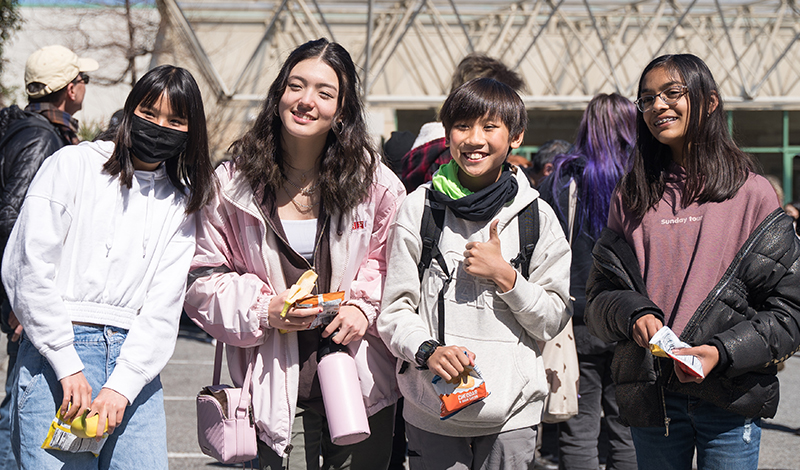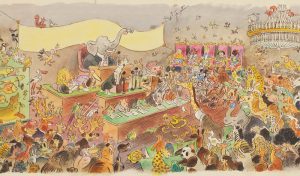The following excerpts are from Ikeda Sensei’s lecture on “The Dragon Gate,” which can be found in Learning From the Writings: The Hope-filled Teachings of Nichiren Daishonin, pp. 113–29.
The youth are the “pillar” that will shoulder world peace. The youth are the “eyes” that will open the future of humanity. The youth are the “great ship” that will lead all people to happiness. Now more than ever, the times call for an alliance of courageous youth who will stand up for truth and justice. Young people are the hope of tomorrow. A society’s future is bright when its youth are filled with passion and enthusiasm and cherish lofty ideals. Young people shape the times. That is why it is our mission and responsibility as Buddhists to foster youth who are able to take on that task.
It is also especially crucial for us in the SGI to ensure a steady flow of youthful successors who can keenly perceive the pain and suffering of the times and pioneer a new age. This is the only way we will be able to accomplish the noble endeavor of kosen-rufu. Consequently, genuine leaders of kosen-rufu foster young people and entrust everything to them. …
I would like to study the Daishonin’s writing “The Dragon Gate” to delve into the deep meaning of this life-to-life transmission. This is a fervent letter sent to Nanjo Tokimitsu, who was then a 21-year-old struggling to protect his fellow believers amid the intense pressures of the Atsuhara Persecution.
In this letter, the Daishonin proclaims: “My wish is that all my disciples make a great vow” (The Writings of Nichiren Daishonin, vol. 1, p. 1003). This great vow is the great vow of the Buddha—which is ultimately the great vow for kosen-rufu, as Nichiren indicates when he says: “The ‘great vow’ refers to the propagation of the Lotus Sutra” (The Record of the Orally Transmitted Teachings, p. 82). And it is the noble vow reflected in the Daishonin’s own declaration in “The Opening of the Eyes”: “Here I will make a great vow. … I will be the pillar of Japan. I will be the eyes of Japan. I will be the great ship of Japan. This is my vow, and I will never forsake it!” (WND-1, 280–81).
In his personal copy of Nichiren’s writings, first Soka Gakkai President Tsunesaburo Makiguchi double-underlined the passage, “Here I will make a great vow,” and also wrote “great vow” in large characters in the margin next to it. He lived out his life true to this great vow, never succumbing to the persecution of Japan’s militaristic authorities. …
Josei Toda also declared: “No matter what enormous hardships might arise, I will never forsake the great vow for kosen-rufu. … I will do what I have to do—that is, strive to save the poor and the sick and those who are suffering. For that purpose, I will keep speaking out with all my might.”
In my youth, I stood up alone as Mr. Toda’s loyal disciple and did everything I could to support and assist him. In the course of those struggles, I inherited this great vow from my mentor. The great vow for kosen-rufu is inherited only through the joint struggle of mentor and disciple. …
My keenest wish now, the area where I am challenging myself most, is to enable all people, particularly the youth, to savor and shine with the deep and abiding joy that comes from dedicating one’s life to the great vow for kosen-rufu. I wish this especially for the youth, since it is to them we must entrust the future.
In “The Dragon Gate,” which we will study this time, the Daishonin is making an ardent appeal for his young disciple to arouse a great vow for kosen-rufu and carry on his struggle.
The Great Vow: Our Foundation in an Age of Confusion
Nichiren Daishonin writes, “Until recently these events seemed to have had no bearing on us, but now we find ourselves facing the same kind of ordeal” (WND-1, 1003). “These events” refers to how Shariputra and those who received the seeds of Buddhahood in the remote past regressed in their practice for an incredibly long period of time. He is pointing out that his disciples at that present moment were facing a similar danger. Needless to say, he is alluding to the Atsuhara Persecution.
The only way to repel this fierce attack of the devil king is to base one’s life on “a great vow” (WND-1, 1003). We cannot bring forth the strength to withstand great hardships or persecution for the sake of the Lotus Sutra unless we make our ultimate goal the attainment of Buddhahood in this lifetime and dedicate our lives to the great vow of the Buddha for the realization of kosen-rufu. Therefore, he calls out from the depths of his being, “My wish is that all my disciples make a great vow” (WND-1, 1003). A life based on a great vow is truly profound and unshakable.
Next, he states, “No one can escape death” (WND-1, 1003). Epidemics had raged throughout the land during 1277 and 1278—the two years prior to when this letter was written. In an effort to halt these epidemics, the era name had been changed from Kenji to Koan (in 1278), but it had no effect. In another writing, the Daishonin describes the terrible toll these epidemics had taken: “People die like trees toppling before a great wind or plants flattened by a severe snowfall” (“On the Three Calamities,” WND-2, 802).
In addition, the people of Japan were assailed by the fear and anxiety that the Mongols might attempt another invasion. The first Mongol invasion occurred in October 1274, five years before this letter was written. The second Mongol invasion happened in April 1281, two years after this writing. The ferocity of the first invasion left the entire populace filled with a sense of dread. They were terrified that Japan might be utterly destroyed if it failed to ward off another attack.
The inexorable reality of death must have been deeply impressed on the minds of the people of the day. Therefore, he writes: “In the end, no one can escape death. The sufferings at that time will be exactly like what we are experiencing now. Since death is the same in either case, you should be willing to offer your life for the Lotus Sutra” (WND-1, 1003).
The Atsuhara Persecution led to the execution of three farmer disciples who are known as the “three martyrs of Atsuhara.” There are two theories about when their execution happened. One states that it occurred on October 15, 1279, just before this letter was written (in November 1279). Another holds that it took place in April 1280, the following year. If we take the former view as being correct, then the words, “Since death is the same in either case, you should be willing to offer your life for the Lotus Sutra,” can be read as an indication that their deaths had profound significance in terms of Buddhism and as praise of their just and courageous struggles. Of course, it is not the Daishonin’s intention to glorify death. He is praising strong faith that does not waver even in the face of death.
Why, then, should there be no cause for regret in laying down one’s life for the Lotus Sutra? Regarding this, he says: “Think of this offering as a drop of dew rejoining the ocean, or a speck of dust returning to the earth” (WND-1, 1003). From the standpoint of eternity, our present existence is as fleeting as dew. And, compared to the colossal scale of the universe, our lives are as tiny as specks of dust. However, by solidly basing our lives on the Mystic Law—which is as vast as the ocean and as firm as the earth—we can establish an unshakable and boundless state of life that is at one with that all-encompassing Law. This is his message. …
Dew, by merging with the ocean, and dust, by returning to the earth, continue and live on eternally, in a manner of speaking. In the same way, our lives, as people dedicated to realizing kosen-rufu, will merge into the Buddhahood in the universe, and eternally repeat the cycle of birth and death in that indestructible realm. Moreover, we will always be reborn to fulfill the supreme mission of kosen-rufu in the place and circumstances of our choosing. In that sense, we can interpret Nichiren’s call to “make a great vow” to mean “enter an eternal and unsurpassed way of being.”
You are reading {{ meterCount }} of {{ meterMax }} free premium articles





